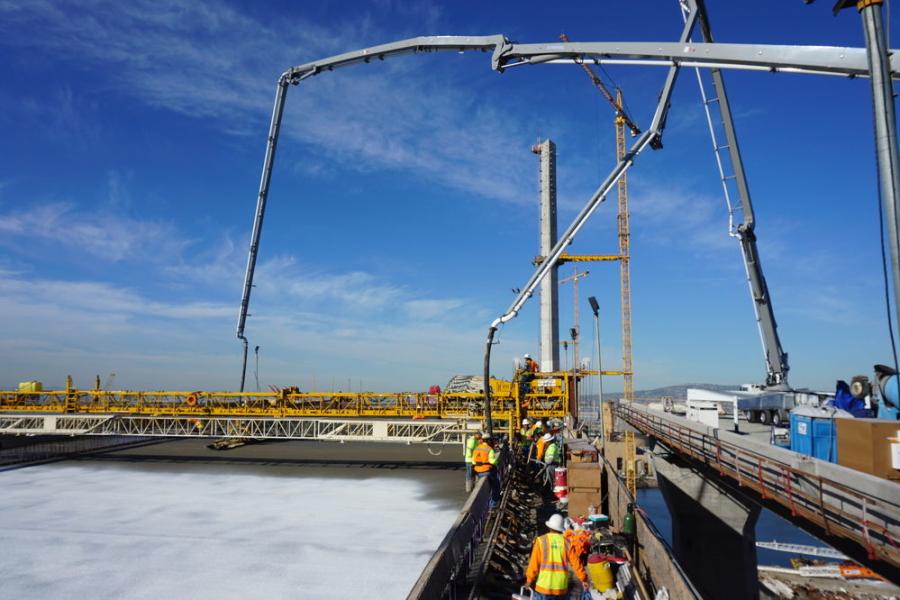Making the adjustments lead to a much smoother paving process for the eastbound lanes and resulted in a better product and higher quality finish.
Rising 515-ft. above the landscape, the twin towers of the new cable-stayed Gerald Desmond Bridge in Long Beach, Calif., are the second tallest of any structure of its kind in the United States. Critical to the U.S. economy, the bridge connects Terminal Island at the Port of Long Beach with the Long Beach Freeway and downtown Long Beach and is the thoroughfare for moving roughly 15 percent of the nation's imported waterborne cargo.
The current 50-year-old Gerald Desmond Bridge being replaced is showing the obsolescence of many similar structures built during that era. It has three traffic lanes in each direction on the incline but only two on the decline, adding to the congestion of a bridge not designed to accommodate 68,000 vehicles per day. Its deck rises only 155 ft. above the water, so today's larger, greener and more modern cargo vessels cannot enter the heart of the port. Protective netting lines the bridge's underside to seize chunks of falling concrete before hitting the water.
The new $828 million bridge is being constructed by SFI JV, consisting of Oakland, Calif.'s Shimmick Construction Inc., Spain's FCC Construction and Italy's Impregilo S.p.A. Leading the joint venture, Shimmick has engineered and constructed several notable landmarks in California.
“We pride ourselves in taking on some of the toughest construction challenges,” said Mike Tung, upper and lower approach bridge manager of Shimmick. “As a part of AECOM, we have the unique ability to handle all construction aspects ourselves, which allows us to successfully complete complex projects.”
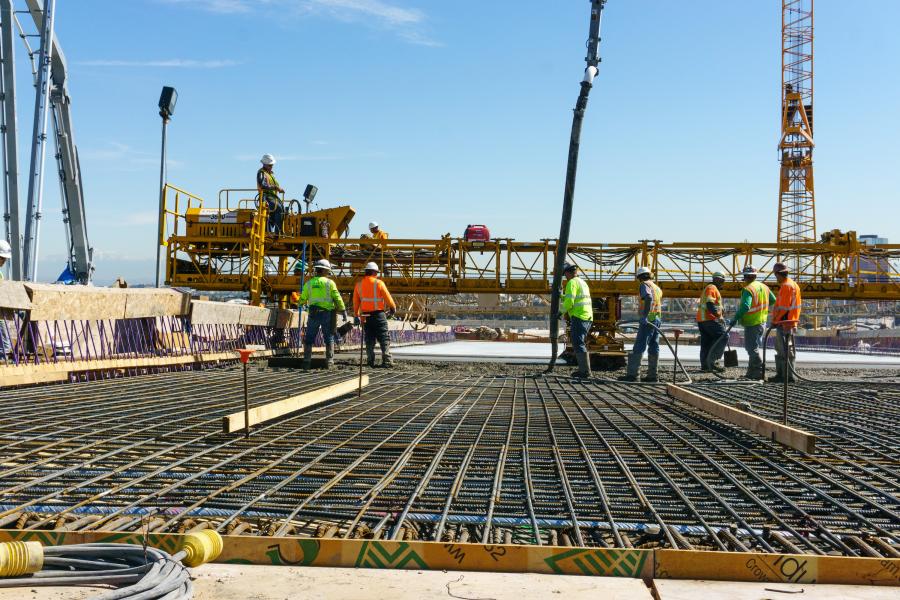
A challenge is what faced Shimmick when paving the roughly 1.6-mi.-long westbound and eastbound lanes of the new Gerald Desmond Bridge. The contractor used, for the first time, high-water-ratio concrete and movable scaffold systems (MSS), which made achieving the stringent smoothness standards difficult without diamond grinding. When grinding costs for the westbound lanes came in higher than expected, Shimmick called on paving equipment manufacturer, Terex Bid-Well for solutions to increase paving quality and lower costs.
Built for a Century
With its expected 100-year lifespan, the new Gerald Desmond Bridge is built to accommodate the current cargo and commuter needs as well as traffic flow well into the future. Three vehicle travel lanes in each direction on both the incline and decline plus emergency lanes will help to improve traffic flow, reduce delays and mitigate hazards posed by accidents and stalled vehicles. The deck's 205-ft. vertical clearance, 50-ft. higher than the previous bridge, will grant access to today's larger cargo ships. A pedestrian pathway, separated from vehicular traffic, will allow walkers and bikers to cross the San Pedro Bay.
The structure's 2,800-ft.-long west approaches on Terminal Island and 3,800-ft.-long east approaches are supported by approximately 90 piers and 350 foundation piles. More than 350 mi. of cable connect to the towers to suspend the bridge's 2,000 ft. of main and back spans, allowing the structure to cross the Port's 220-ft.-wide back channel. Built to withstand earthquakes, the bridge's strategically placed hinges between sections are designed to prevent damage by accommodating structure movement.
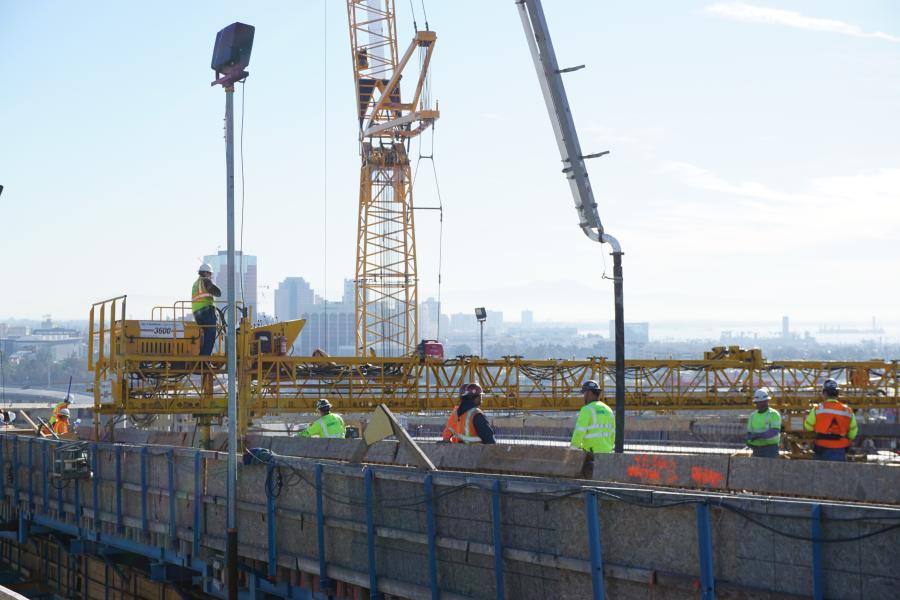
To reduce construction time on the design-build project, SFI JV is using two MSS units to construct the upper level approaches.
“It's new to Shimmick, but our joint-venture partners have used it on other projects outside of the United States,” said Tung.
The 300-ft.-long structure moves from pier to pier allowing each span to be completely constructed at one time.
“We complete about one span per month per MSS, and we have 46 spans to build,” he said.
Paving Challenges
Shimmick's crews are tasked with paving 775,000 sq. ft. of the bridges' 1 million sq. ft. of deck, and they faced several challenges when paving the deck with its Terex Bid-Well 3600 and 2450 pavers. Structure design required paving width changes nearly every pour.
“We paved at widths ranging from 50- to 90 feet wide with our 3600 paver, and some of the pours required us to vary paving width,” said Tung.
The 3600 paver's end segments are built to accommodate up to 30 ft. of on-the-fly paving width changes.
While the MSS helps to condense bridge segment construction time, it also contributed to some of the paving challenges for the contractor.
“You can only pave in the direction the MSS is moving, so we had no choice in whether we paved up or down the 5 percent grades,” said Tung.
Jason McCann, service engineer of Terex Bid-Well, added, “While our pavers can be configured and set-up to pave for either, many contractors prefer to pave uphill.”
On previous deck pours dating back to 2015 with the 3600 paver, Shimmick's crews paved with a standard 4- to 5-in. slump concrete. Using the MSS on the Gerald Desmond Bridge, crews were required to use a high water-to-cement-ratio concrete.
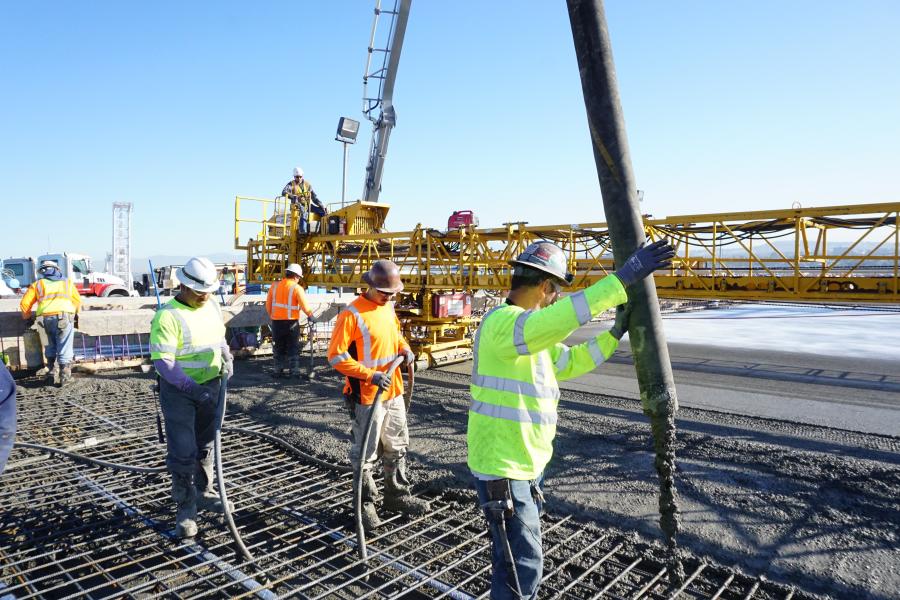
“Concrete slump was roughly twice what we typically pave — about 8 inches,” said Tung.
Concrete consistency also was an issue.
“Some concrete deliveries were at a higher slump, while others were at a lower slump,” said McCann. “Concrete pavers like to have consistency with the mix. Otherwise, it's hard to get the paver set-up dialed-in.”
After crew members completed paving the westbound travel lanes, Shimmick ran a profilograph over the deck. Smoothness specifications required no more than five counts registered over a 100-ft. span and no more than 1/4-in. high spot within a 12-ft. level.
Shimmick anticipated the tests to come back with better results, as they have successfully used the 3600 paver to meet smoothness specifications on many other bridge projects. Unfortunately, more grinding than expected was necessary, and grinding to spec can be expensive.
“Grinding costs about $6 per square yard, and we spent more on grinding than anticipated on the westbound lanes,” said Tung.
Company officials searched for answers and zeroed in on the challenges associated with using the MSS and high-slump concrete. These obstacles posed a challenge to get the paver's configuration dialed in to excel under these difficult circumstances.
“At times, we would have too much concrete in front of the augers and at others, we wouldn't have enough,” said Tung.
Shimmick requested an onsite consult with Terex Bid-Well to offer suggestions. McCann made the visit to observe the crew and make recommendations on how to boost paving quality.
Concrete Advice
McCann quickly noticed that the work crew was working much harder than they should be.
“The workers were raking concrete away from the paving carriage and pushing concrete in low spots, so I initially recommended changes to the way they were loading mud in front of the paver,” said McCann.
At times, too much wet concrete would run under the paving carriage's Rota-Vibe and dual rollers, and smoothness suffered. McCann offered Shimmick's crew advice on setting up the paving carriage's augers.
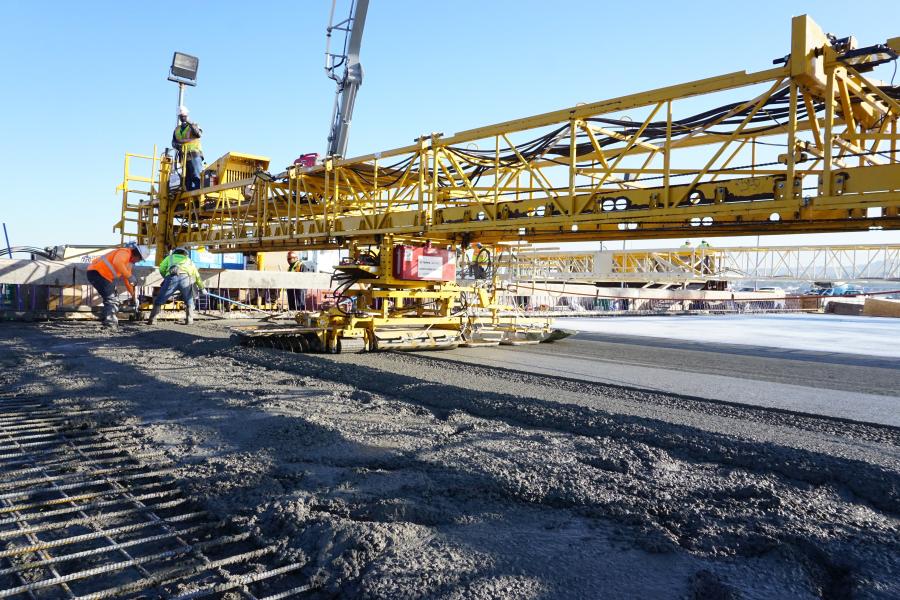
“Two 8-inch diameter strike-off augers with double flighting lead the paving carriage to meter concrete more effectively than single-auger systems,” said McCann. “We just needed to fine-tune the auger height to adapt to the paving conditions. When paving uphill, Shimmick's crews needed to lower height slightly to counteract the wet mix running toward the paver. When paving downhill, they needed to raise the augers, since the concrete would run away from the paver.”
Pre-pour frame set-up also was addressed by McCann and the crew. Initially only the carriage rail was stringlined for making adjustments.
“It is best to stringline both the main frame and carriage rail for set-up, especially on a project that requires multiple paving width adjustments,” said McCann. “The main truss allows for the major grade and cross-slope adjustments to be made across the entire truss section, and then the fine-tune adjustments of 4- to 5 inch lengths can be made at the carriage rail. This increases set-up speed, makes it easier to add/remove truss segments and eliminates the potential of running out adjustment toward the end of the paver and starting all over again.”
McCann worked with Shimmick to adjust both the 3600 and 2450 pavers on the job, and the decision to bring in a machine expert to help with this challenging project is paying dividends for Shimmick.
“Jason made some very good observations,” said Tung. “The paving process for the eastbound lanes is a going lot smoother, and we are getting a much better product and higher quality. We anticipate the profilograph tests to come out a lot better.”
Today's top stories



